A panoramic dental x-ray captures a single image that shows your teeth, jaw bones and surrounding facial structures. Dentists and oral surgeons use these OPG x-rays to diagnose dental problems and plan treatments, especially for orthodontics, dental implants and other restorative dentistry.
If you intend to get dental treatment abroad, your clinic will probably request a panoramic teeth x-ray to help them provide an accurate quotation.
Here you can discover how panoramic radiography works, what to expect from the procedure, and what a dental x-ray costs in the UK. We also explain how to send an x-ray via email, in case this is something you need help with.
What is a panoramic dental x-ray?
Unlike other kinds of dental x-ray, which capture just one tooth or a section of the mouth, panoramic x-rays show the whole mouth in one single image. The technical term for a panoramic dental x-ray is an orthopantomogram, so you can see why it’s referred to as an OPT or OPG x-ray for short.
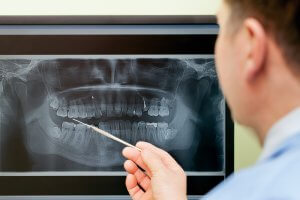
Dental radiography helps dentists and oral surgeons identify dental issues that would otherwise be difficult or impossible to spot. These include:
- Tooth decay, especially under a filling or between two teeth
- Tooth abscess infections at the end of a tooth root or below the gum line
- Bone loss in the jaw bone from gum disease or a missing tooth
- Hyperdontia and hypodontia (the conditions of having too many or too few teeth genetically)
- Tumours linked to jaw cancer or oral cancer
Importantly, for people seeking dental treatment overseas, a panoramic x-ray makes it possible for dentists to accurately assess your oral health condition remotely and provide a cost estimate for your treatment plan. You will still have a full examination when you arrive at the clinic, but by then you will already have a good idea of the treatment needed and approximate cost.
In some cases it may also be necessary to perform a periapical radiograph (which focuses on several teeth in detail) or a CT scan. A dental CT scan produces a 3D image and is particularly helpful for assessing bone density when you’re getting tooth implants.
How do you get a panoramic x-ray?
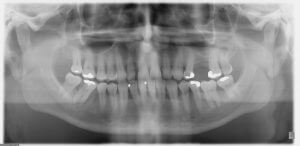
Thousands of dental clinics in the UK have panoramic dental x-ray machines installed in their premises, so you can start by asking your usual dentist. If they don’t have the right equipment, they should be able to recommend a nearby clinic that does.
Imaging centres like CT Dent operate independently, providing dental x-rays and CT scans at locations across the UK. You will need a referral from your dentist in order to book an appointment there.
The orthopantomogram procedure
A panoramic dental x-ray machine has two sides: one containing an x-ray tube and the other containing a film or detector. These are positioned on a rotating arm which revolves 180 degrees around your head to capture the full image.
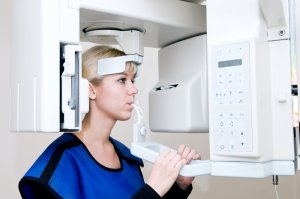
In preparation for your teeth x-ray you may be asked to:
- Remove any jewellery, glasses, or other metal objects that might obscure the images
- Put on a lead apron which protects the rest of your body from exposure to radiation
- Bite down on a thin block to open your mouth slightly
The radiologist will position your head on a chin rest and there may be small supports at the front and sides of your head. It’s important you remain completely still to get a clear image. The procedure usually takes place while you are standing, but if you feel more comfortable sitting, the machine can be adjusted. It can also accommodate wheelchair users.
It only takes about 10-20 seconds to capture the image. The computerised x-ray is sent straight to the radiologist so they can immediately view it and carry out an assessment.
Your dentist may recommend you get new mouth x-rays taken every 6-24 months, depending on your oral health.
Watch the video below to see one patient describe how impressed he was with the technology used and the speed of the process when he got a dental x-ray:
Are dental x-rays safe?
When performed in line with the correct safety precautions, including those described above, dental x-rays are considered extremely safe.
Although they involve a small amount of radiation, this does not remain in the body following the procedure. Even for babies and small children, who are more sensitive to radiation, the amount of exposure from a dental x-ray is not considered a risk. Indeed, x-rays are an important tool for monitoring the growth and development of children’s teeth and jaws.
Whereas other kinds of x-rays involve equipment being placed in the mouth, panoramic x-rays take place externally. For this reason, this is often the preferred method for baby and child teeth x-rays.
Everyone is constantly exposed to radiation from the sun, televisions, plane flights, and even bananas! While this so-called “background-level” of radiation is 100% safe for most people, children are more sensitive to radiation exposure, so it’s only natural to be concerned about dental x-rays.
Modern dental x-rays use a very, very, very small amount of radiation and aren’t something you should be worried about. If, as a parent or guardian, you’re concerned about dental x-rays, ask your dentist:
- What are we hoping this x-ray will reveal?
- Are there other diagnostic tests we can use instead?
- What are the risks of not getting an x-ray done?
Dr. John Will, Children’s Dentistry of Charlottesville
The only time that dental x-rays may not be safe is during pregnancy. If you are pregnant, or you think you might be, notify your dentist or radiologist. They may well decide to postpone any dental radiology until after you have given birth.
Are panoramic dental x-rays necessary?
It’s not always necessary to take a full panoramic x-ray. A smaller bitewing x-ray may be sufficient if your dentist needs to focus on just a few teeth.
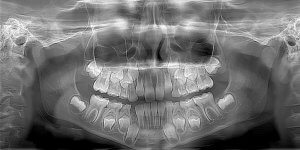
However, if your dentist needs to assess your whole mouth – including your jawbone – then a full panoramic x-ray may be necessary. This is often the case when assessing the overall oral health of new patients, or when planning dental implant treatment.
X-rays are also an important tool for monitoring the growth and development of children’s teeth and jaws. Your dentist will recommend appropriate radiology according to any conditions they need to assess.
How much does a panoramic dental x-ray cost in the UK?
If you have an x-ray taken as part of an NHS treatment course, it will be included in the price of your treatment, whichever band that falls into.
When it comes to private treatment, panoramic dental x-rays cost anywhere from £20 to £100. Prices depend a lot on the location of your dentist and their business overheads.
Note that some clinics abroad will offer to refund your panoramic dental x-ray charge as part of your treatment. If this is the case for you then you have the luxury of not worrying too much about the initial cost.
Tips for sending your teeth x-ray digitally
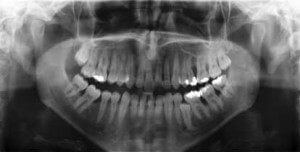
So, now you know how to get a dental x-ray. But what if you need to send it to a dentist overseas or elsewhere in the UK?
The easiest way to get a digital dental x-ray that you can send via email is to ask the clinic for a digital copy. They may be able to email it to you, or you might get a CD with a file you can attach to an email.
If you only have a hard copy of your teeth x-ray, there are two ways you can capture it digitally:
- Place your x-ray in front of a blank white computer screen (you can achieve this by opening a new Word document, for example).
- Place your x-ray on a plain white background (like printer paper) in a well lit area.
You can take a photo with your smartphone or camera, but don’t use a flash. Also try to position the photo so there is no glare from other light sources reflecting off the x-ray film.
Once you have a good photo, you can attach it to an email and send it on to whoever requests it.
Conclusion
Panoramic dental x-rays are a common diagnostic tool for dentists and oral surgeons. The quick and non-invasive procedure captures an image of all your teeth and both jaws, enabling an accurate assessment of your oral health needs.
If you’re planning to get dental work abroad, you’ll almost certainly need to provide your chosen clinic with a panoramic teeth x-ray so they can prepare a personalised treatment plan without seeing you in person. Fortunately, most clinics are able to provide digital x-rays so this process is quite straightforward.
Radiologyinfo.org: Panoramic Dental X-ray. Consulted 10th April 2019




